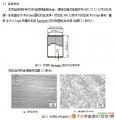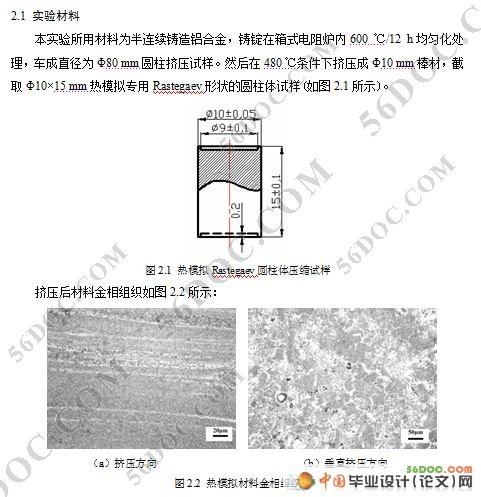高强高耐蚀性钎焊铝合金材料的开发(材料工程)

摘 要
为了满足市场对铝热交换器用钎焊铝合金材料的性能要求,同时又要规避受多项欧美国家注册专利保护,急需开发一种新型铝合金,使其耐腐蚀性能、力学性能和工艺性能达到或超过所谓“长寿命”铝合金材料的性能指标。本文通过研究一种新型高强高耐蚀性钎焊铝合金的热变形行为,获得材料真实应力应变曲线,建立热变形本构关系,为优化合金后续热轧工艺提供材料数据,以及对合金热轧变形组织和性能的预测分析。本文在Gleeble-1500热模拟机上,采用圆柱体轴对称等温压缩试验,对一种新型高强高耐蚀性铝合金高温流变应力进行了研究。实验过程变形温度为350 ℃~550 ℃,应变速率为0.01 s-1~10 s-1,变形后立即进行水淬。主要研究内容如下:
1. 铝合金的真应力-应变曲线出现明显的稳态变形特征。在低应变速率条件下应力迅速增大,无明显峰值,到达一定值后便趋于稳态变形。在较高应变速率下出现一个明显的峰值,且其明显大于其后的峰值,随后流变应力出现较大下降及周期性波动,最后也趋于稳态变形,表现出不连续动态再结晶特征。
2. 本构分析表明:可以采用双曲正弦来描述铝合金高温热压缩变形流变行为,其热变形激活能为154.3402 kJ/mol。
3. 误差分析表明:计算峰值应力与实测峰值应力之间的相对误差基本在±10%之内,平均相对误差为3.37%,吻合较好;温升修正前后的峰值应力变化很小。
4. 对显微组织的研究表明:在变形过程存在变形不均匀性,变形温度的升高和变形速率的增大,有利于再结晶的发生。
关键词:钎焊铝合金;热压缩变形;本构方程;动态再结晶
Exploitation on brazing aluminum alloy with high strength and high corrosion resistant
Abstract
In order to meet the market requirements of brazing aluminum alloy for automobile heat exchangers,and avoid a number of registered patent protection in European countries,it is necessary to develop a new aluminum alloy ,so that the corrosion resistance, mechanical properties and process performance meets or exceeds the so-called "long life" aluminum alloy.In this present,the hot deformation behaviors of a new brazing aluminum alloy was studied by means of compression deformation tests on Gleeble 1500 machine at strain rates ranged between 0.01s-1~10s-1 and deformation temperature 350℃~550℃,and associated structural changes were studied by observations of metallographic . The results are shown as following:
1. The true stress-true strain curves of brazing aluminum alloys appears steady-state deformation features apparently. At low strain rate, the true stress increases with true strain rapidly and enters a steady state after reached peak flow. At high strain rate, the true stress decreases sharply after the peak, then the curves enter steady-state deformation stage.
2. Constitutive analysis suggestes that the peak stress can be represented by a Zener-Hollomon parameter in the hyperbolic-sine-type equation, with the hot deformation activation energy of 162.128 kJ/mol.
3. Error analysis shows that relative errors between calculated peak stress and measured peak stress are roughly within ±10%,and average relative errors was 3.37%.The peak stress changed very little after temperature correction.
4. The microstructural shows that inhomogeneous deformation was appeared. it is benefit for recrystallization with the increase of deformation temperature and deformation rate.
Key words: Brazing aluminum alloy;Hot compression deformation;Consitutive relationship;Dynamic recrystallization [资料来源:https://www.doc163.com]
本文研究目的、研究内容及研究路线
本文研究一种新型高强高耐蚀性铝合金的高温变形行为,为合金板材、带材的控制轧制及优化合金续热轧工艺提供理论依据,同时对合金热轧变形组织和性能的预测分析。
本实验在Gleeble-1500热模拟机上,对经过均匀化处理挤压后的棒材试样进行不同应变速率、变形温度和变形量的热压缩实验,获得材料真实应力应变曲线,建立热变形本构关系,观察显微组织结构,求得材料本构方程,并通过温升修正及误差分析对所求本构方程的准确性进行验证。
本文在Gleeble-1500热模拟机上,采用圆柱体轴对称等温压缩试验,对一种新型高强高耐蚀性铝合金高温流变应力进行了研究。实验过程变形温度为350 ℃~550 ℃,应变速率为0.01 s-1~10 s-1,变形后立即进行水淬。得出如下结论:
1. 铝合金在低应变速率条件下应力迅速增大,无明显峰值,到达一定值后便趋于稳态变形。在较高应变速率下迅速一个明显的峰值,且其明显大于其后的峰值,随后后流变应力出现较大下降及周期性波动,最后也趋于稳态变形,表现出不连续动态再结晶特征;
2. 铝合金的热变形激活能Q值为154.3402KJ/mol,热压缩变形时的流变应力方程为:
3. 温升修正前后的峰值应力变化很小,故无须取修正后的峰值应力来重新计算其本构方程。误差分析得出相对误差基本在±10%以内,平均相对误差为3.37%,吻合较好,表明该本构方程能很好地表征实验材料的高温流变行为; [资料来源:Doc163.com]
4. 对显微组织的研究表明:变形过程存在变形不均匀性,中心区域变形量最大;变形温度的升高和变形速率的增大,有利于再结晶的发生。

目 录 20000字
第一章 绪论 1
1.1 研究背景 1
1.2 汽车热交换器铝制化 2
1.3 铝合金热制生产技术 4
1.3.1 国内热轧技术现状 4
1.3.2 影响热轧显微组织的主要因素 6
1.4 热变形行为研究模型简介 7
1.5 金属高温塑性流变行为的研究内容 10
1.5.1 流变应力 10
1.5.2 动态回复 10
1.5.3 动态再结晶 12
1.6 本文研究目的、研究内容及研究路线 14
第二章 实验方案 15
2.1 实验材料 15
2.2 实验方法 15
2.3 显微组织观察 16
第三章 结果分析 17
3.1 高温热变形真应力-真应变曲线 17
3.2 流变应力方程 18
3.2.1 应变速率,变形温度,流变应力之间的本构方程 18
3.2.2 本构方程中相关系数的求解 19
3.2.3 本构方程 23
3.3 温升修正 24
3.4 误差分析 25
3.5 高温热变形组织研究 26
3.5.1 不同位置的显微组织对比 26
3.5.2 变形温度对显微组织的影响 27
3.5.3 变形速率对显微组织的影响 28
第四章 结论 30
致 谢 31
参 考 文 献 32
